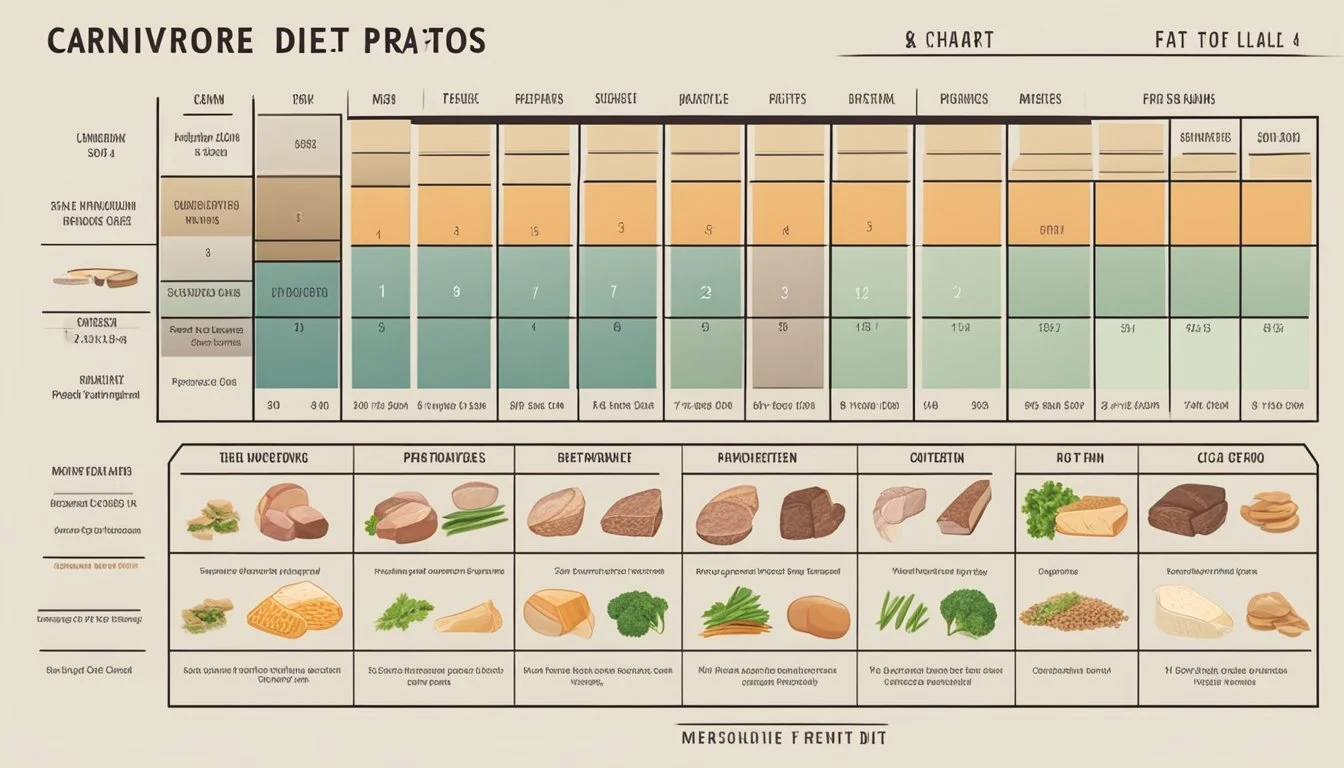Carnivore Diet Fat to Protein Ratio
Optimal Balance for Health & Performance
This Article is Part Of Our Guide on the Carnivore Diet
The carnivore diet, centered on the exclusive consumption of animal products, places significant emphasis on understanding the appropriate macronutrient ratio—particularly, the balance between fat and protein. This fat-to-protein ratio is a crucial aspect of the diet as it affects various outcomes, from energy levels and weight management to overall health. Enthusiasts of this lifestyle often aim for a ratio that aligns with their personal health goals, whether that is weight loss, muscle gain, or maintenance of general wellbeing.
Determining the ideal ratio depends on an individual's activities and energy demands. Generally, a higher intake of fat is recommended as the primary source of calories, accounting for roughly 70-80% of daily caloric intake, with the remaining 20-30% coming from protein. A typical concern among those following the carnivore diet is ensuring adequate fat consumption, as protein is readily available in the meats consumed.
Adjusting the diet to this particular macronutrient balance involves careful selection of meat cuts and understanding the nutrient profile of different animal-based foods. For example, ribeye steaks (What wine goes well with ribeye steak?), favored for their taste and high-fat content, can be an effective component of the diet for getting the right fat-to-protein ratio. However, personal preference and dietary goals should guide the selection and proportion of meats, ensuring the diet is tailored to the individual's needs and aspirations.
Understanding the Carnivore Diet
The carnivore diet, also known as an all-meat diet, emphasizes the consumption of animal products and virtually excludes all plants. This section explores its historical roots, the basic principles, benefits, potential risks, and the different variations that exist.
Historical Context
The carnivore diet has been considered by some to be a more extreme version of the paleo diet. It reflects a way of eating that's presumed to be similar to that of our early ancestors. Historically, societies with limited access to plant foods, like the Inuit, subsisted mostly on animal products out of necessity.
Fundamentals of the Carnivore Diet
At its core, the carnivore diet is an animal-based diet focusing on protein and fat as primary sources of calories, while carbohydrates are minimized or eliminated. The main staples of this diet include meat, fish, eggs, and dairy, with an emphasis on high fat content to provide energy.
Macros for the Carnivore Diet:
Protein: Essential for muscle growth and repair.
Fat: Serves as the main energy source.
Carbohydrates: Typically absent or negligible.
Fat to Protein Ratio: Varies based on personal goals, this ratio is critical to prevent issues like rabbit starvation, the effects of consuming too lean meat without adequate fat.
Benefits of the Carnivore Diet
Proponents of the carnivore diet report benefits such as weight loss, increased satiety, mental clarity, and reduced inflammation. The diet's high-fat and protein content is believed to influence satiety hormones, aiding in appetite control.
Potential Risks and Considerations
The exclusion of plant-based foods raises concerns about micronutrient deficiencies, as plants are primary sources of certain vitamins, minerals, and fiber. There can also be risks of increased cholesterol and potential heart disease from high saturated fat intake. Additionally, individuals may experience initial symptoms such as diarrhea, due to the significant dietary change.
Variations of the Carnivore Diet
Different iterations of the carnivore diet allow for some inclusion of dairy or even low-carb plant foods, to add variety or address potential micronutrient deficiencies. The strictness of the fat to protein ratio can vary depending on the individual’s level of physical activity and personal health goals.
Macro Ratios and Nutritional Targets
Understanding the precise fat to protein ratio and how to calculate your daily macronutrient intake is essential for achieving specific health goals on the carnivore diet.
Optimal Fat to Protein Ratio
The ideal fat to protein ratio on the carnivore diet varies depending on one's energy needs and health objectives. Generally, individuals aim for a higher intake of fat, as fat provides roughly 9 calories per gram, supplying a dense energy source. Protein, providing approximately 4 calories per gram, is vital for muscle maintenance and growth. Those seeking weight loss might opt for a moderate fat to protein ratio to utilize body fat reserves for energy.
Calculating Daily Macronutrient Intake
To calculate daily macronutrient intake, start with determining total calorie needs for the day. Then, convert these needs into grams of fat and protein. Using a macro calculator can streamline this process, considering factors such as body composition, activity level, and overall health status.
Calories from fat: Multiply grams of fat by 9.
Calories from protein: Multiply grams of protein by 4.
Adjusting Ratios for Health Goals
Adjusting fat to protein ratios is crucial for aligning with health goals:
Weight loss: A modest increase in protein relative to fat can help preserve muscle mass.
Muscle growth: Sufficient protein alongside increased calories from fat supports anabolism.
Maintenance: Balance macros for a sustainable approach to health and well-being.
Stress and Activity: Physically active individuals may require more protein and fat to recover and fuel their activities.
Common Sources of Fat and Protein
The carnivore diet focuses solely on animal sources:
Animal fat: Provides a highly satiating and rich source of energy.
Protein: Primary sources include beef, pork, poultry, fish, and organ meats like liver.
Moreover, fatty cuts like pork belly (What wine goes well with pork belly?) and eggs yield a beneficial blend of fat and protein, while cheese and dairy can be included for variety.
Beef (ground)
Protein: 26g
Fat: 15g
Chicken breast
Protein: 31g
Fat: 3.6g
Protein: 9g
Fat: 53g
Eggs
Protein: 13g
Fat: 11g
Cheese (Cheddar)
Protein: 25g
Fat: 33g
Beef liver
Protein: 20g
Fat: 3.6g
Incorporating the Carnivore Diet into Your Lifestyle
When adopting the carnivore diet, understanding how to effectively incorporate high-fat and protein-focused meals into daily life is essential. This includes planning meals rich in these macronutrients, aligning physical activities to support muscle growth, and tracking body composition changes to ensure goals are met.
Meal Planning and Recipes
Successful incorporation of the carnivore diet requires strategizing meal plans and finding recipes that balance the high protein and fat intake. For instance, a daily plan might involve:
Breakfast: Scrambled eggs with cheese and a side of bacon.
Lunch: Grilled ribeye steak, chosen for its favorable fat to protein ratio of about 70% calories from fat and 30% from protein.
Dinner: Roasted lamb shoulder with butter-basted salmon.
In terms of recipes, emphasize meals that are rich in both protein and fats, such as pork chops (What wine goes well with pork chops?) with cream sauce or chicken thighs (What wine goes well with chicken thighs?) with skin cooked in olive oil.
Physical Activity and Exercise
Physical activity should be tailored to an individual's energy levels on a carnivore diet. Since the diet is rich in protein and fats, which support muscle maintenance and growth, exercise routines can be adjusted to prioritize weight training and resistance exercises. Regular training sessions should be aimed at increasing muscle mass and enhancing body composition while considering the ample calories from fat as a primary energy source.
Tracking Progress and Adjustments
Monitoring changes in body fat percentage and muscle tone is vital to assess the effects of the carnivore diet on body composition. Users should track their progress by:
Taking body measurements and weight regularly.
Using a journal or app to record physical activity and dietary intake.
Adjustments to the meal plan and training regimen should be made based on these observations to ensure continued alignment with weight loss or maintenance goals. For example, if energy levels dip or muscle gains plateau, increasing fat intake or adjusting the type of physical activity might be necessary.
Monitoring Health and Nutrition
When adopting a carnivore diet, it's crucial to keep track of health and nutritional intake to ensure the body receives all the necessary vitamins and minerals while assessing the diet's broader health effects.
Vitamins and Minerals
On a carnivore diet, the primary sources of macronutrients are fat and protein, and careful attention must be paid to intake levels to maintain health. Since the diet excludes plant-based foods, obtaining a complete profile of essential nutrients can be challenging:
Vitamins: Fat-soluble vitamins A, D, E, and K are found abundantly in animal products. Consuming organ meats, such as liver, provides a rich source of these, along with B vitamins which are crucial for numerous metabolic processes.
Minerals: Red meat and seafood are fruitful sources of minerals such as iron, zinc, and selenium.
Adequate fat intake is not only important for satiety but also aids in the absorption of these fat-soluble vitamins. However, one should avoid excessive protein without enough fat, which can lead to protein poisoning, characterized by symptoms like fatigue and diarrhea.
Understanding Carnivore Diet Health Effects
It's vital to monitor how the body responds to a carnivore diet in terms of inflammation and digestion. Individuals may experience variations in these areas due to changes in the diet, and it is often recommended to track the following:
Blood Markers: Regular blood tests can provide insights into cholesterol levels, liver function, and other critical health markers.
Digestion: Some people may find improved digestive health due to the elimination of certain plant compounds that they might have had trouble digesting.
Inflammation: Animal-based diets can either alleviate or exacerbate inflammation, depending on an individual's response to the removal of plant-based foods.
Through careful tracking and regular health check-ups, individuals can tailor their carnivore diet to not only optimize their fat to protein ratio for satiety and energy but also ensure they are obtaining all essential nutrients for long-term health.
Special Considerations for Specific Groups
When tailoring the carnivore diet's fat to protein ratio, certain populations have unique requirements based on their lifestyle and health status. It's essential to adjust macronutrient intake to support their specific energy needs and health goals.
Athletes and High-Activity Individuals
For athletes and those engaged in high levels of physical activity, muscle growth and recovery are paramount. They typically require a higher intake of protein to support muscle repair, which might lean towards a greater protein to fat ratio. However, they must also ensure sufficient fat intake for sustained energy, especially if they are in ketosis. A ratio of 2:1 of fat to calories may suffice for moderate training, but those with heavy training schedules may adjust this ratio to meet increased metabolic demands.
Protein: Essential for muscle repair and growth
Fat: Provides a dense form of calories for energy
Macros: Adjusted to support extended periods of physical activity
Individuals with Health Conditions
Those managing specific health conditions must carefully consider their macronutrient ratio. For instance, someone dealing with inflammation or autoimmune conditions might benefit from a higher fat intake, as it can potentially modulate inflammatory responses. In these cases, the fat to protein ratio could skew to as much as 3:1 in favor of fat.
For individuals at risk of protein poisoning or with compromised kidney function, moderating protein intake relative to fat is crucial. Monitoring blood markers can provide guidance for these adjustments. Additionally, fat serves as a vehicle for the absorption of fat-soluble vitamins, which are essential nutrients. People on the carnivore diet must be attentive to the balance of these nutrients to maintain overall health.
Health Conditions: Adjust fat to protein ratio to manage or support treatment
Protein Poisoning: Avoid excess protein to prevent health complications
Blood Markers: Use as a guide to tailor the diet to individual health needs
Common Questions and Myths
In the exploration of the carnivore diet, particularly concerning the fat to protein ratio, one encounters various misconceptions and common queries. This section addresses such myths and concerns with clarity and precision.
Debunking Carnivore Diet Myths
Myth: The carnivore diet lacks essential nutrients, leading to deficiencies.
Fact: A well-planned carnivore diet can provide all necessary nutrients except for fiber and vitamin C, which can be managed by selecting nutrient-dense, organ meats and fat from grass-fed animals.
Myth: A high intake of fats, especially saturated fat, on the carnivore diet increases the risk of cholesterol-related diseases.
Fact: The relationship between saturated fat, cholesterol, and heart disease is not conclusive. Many individuals report maintaining healthy cholesterol levels on this diet.
Myth: The carnivore diet causes rabbit starvation due to too much lean protein.
Fact: Rabbit starvation, or protein poisoning, occurs when one consumes protein without adequate fat. The carnivore community advocates for a proper fat-to-protein ratio to prevent this issue, often aiming for a ratio that promotes ketosis, a state where the body burns fat for fuel.
Addressing Common Concerns
Concern: Will the lack of carbs and fiber lead to digestive issues such as diarrhea?
Answer: Individual responses vary; however, many report an adaptation period followed by normal digestive function, as the gut microbiota adjusts to a fiber-free, all-meat diet.
Concern: Is it possible to feel full and satisfied without carbs?
Answer: Satiety is often reported to be higher on the carnivore diet due to the satiating effects of proteins and fats. This can help with natural calorie intake regulation.
Concern: How can one ensure a balance of nutrients, like calcium and vitamins, without plant-based foods?
Answer: Choosing a variety of meats, including organ meats and bones (such as bone broth), can provide a broad spectrum of vitamins and minerals, including calcium.
Concern: Are sodium intake and the lack of dietary fiber problematic on the carnivore diet?
Answer: The body’s requirement for sodium may differ when on a diet devoid of processed foods and carbs. Concerning fiber, while it is generally considered beneficial for bowel movements, some argue that an all-animal-based diet provides digestive relief without it.
Resources and Tools
Finding the correct balance of macronutrients is essential on a carnivore diet. The right resources and tools can guide individuals through the process of calculating macros and understanding the ideal fat to protein ratio.
Calculators and Macro Tracking
For those on a carnivore diet, macro calculators are indispensable for monitoring daily caloric intake from fat and protein. A well-designed macro calculator will aid in determining the grams of fat and protein needed to meet dietary goals. For example, using a calculator, individuals can specify their physical activity levels to tailor their macros accordingly, ensuring their fat to protein ratio aligns with their energy requirements.
To track these macros effectively, there are numerous online tools and apps that log daily intake and compute the calories from protein and fat. These tools often come with features that adjust the dietary plan as per the user's progress and changes in their physical activity levels, making macro tracking clear and straightforward.
Educational Materials and Books
For those seeking to deepen their understanding of the carnivore diet, educational materials and books are available that delve into the nuances of fat to protein ratios and the principles of macro calculation. They cover topics from basic carnivore diet guidelines to more intricate subjects like protein toxicity and how it informs the optimal macros for different individuals.
In particular, books tailored to the carnivore lifestyle often include sections on the importance of listening to one's body and adjusting the fat to protein ratio based on individual tolerance, health goals, and energy needs. They can be an invaluable resource for both new and seasoned adherents of the carnivore diet who need to reconcile their intake of calories from protein and fat with their overall health objectives.






